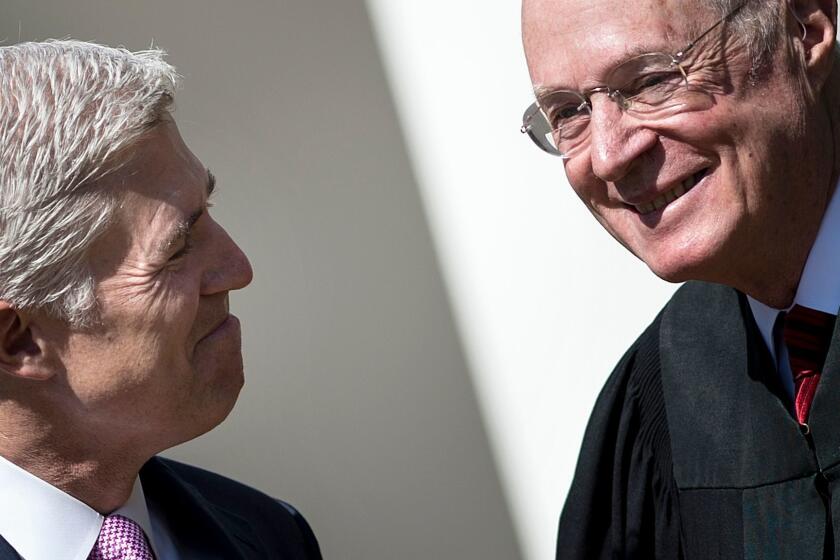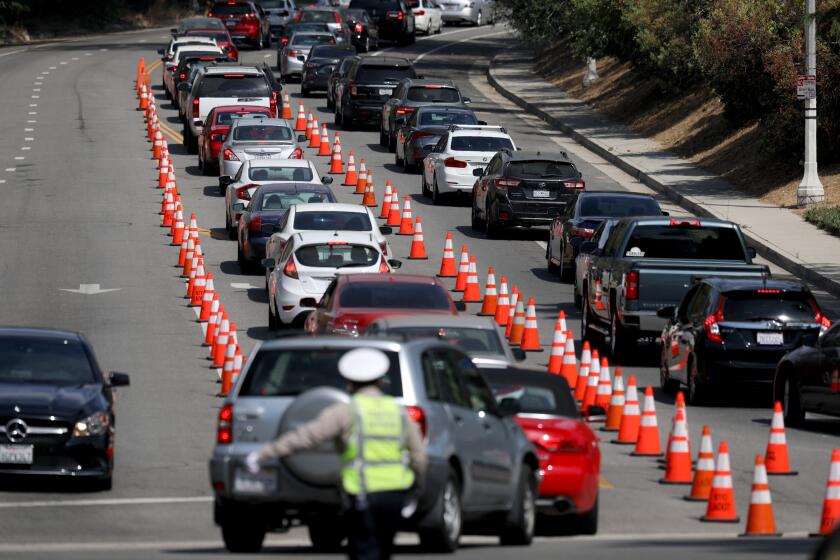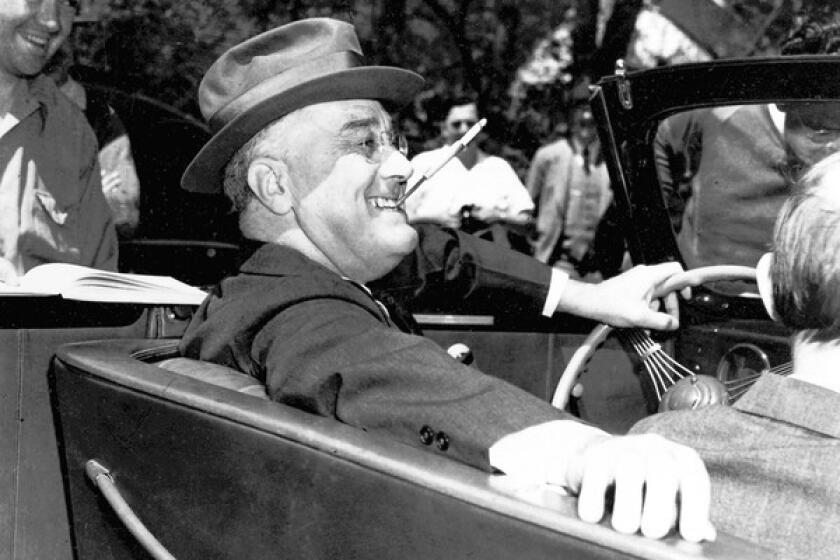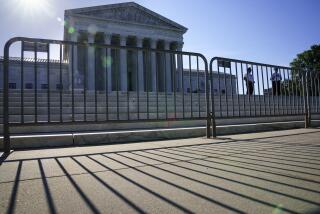Column: Ginsburg’s death makes Supreme Court expansion much more urgent
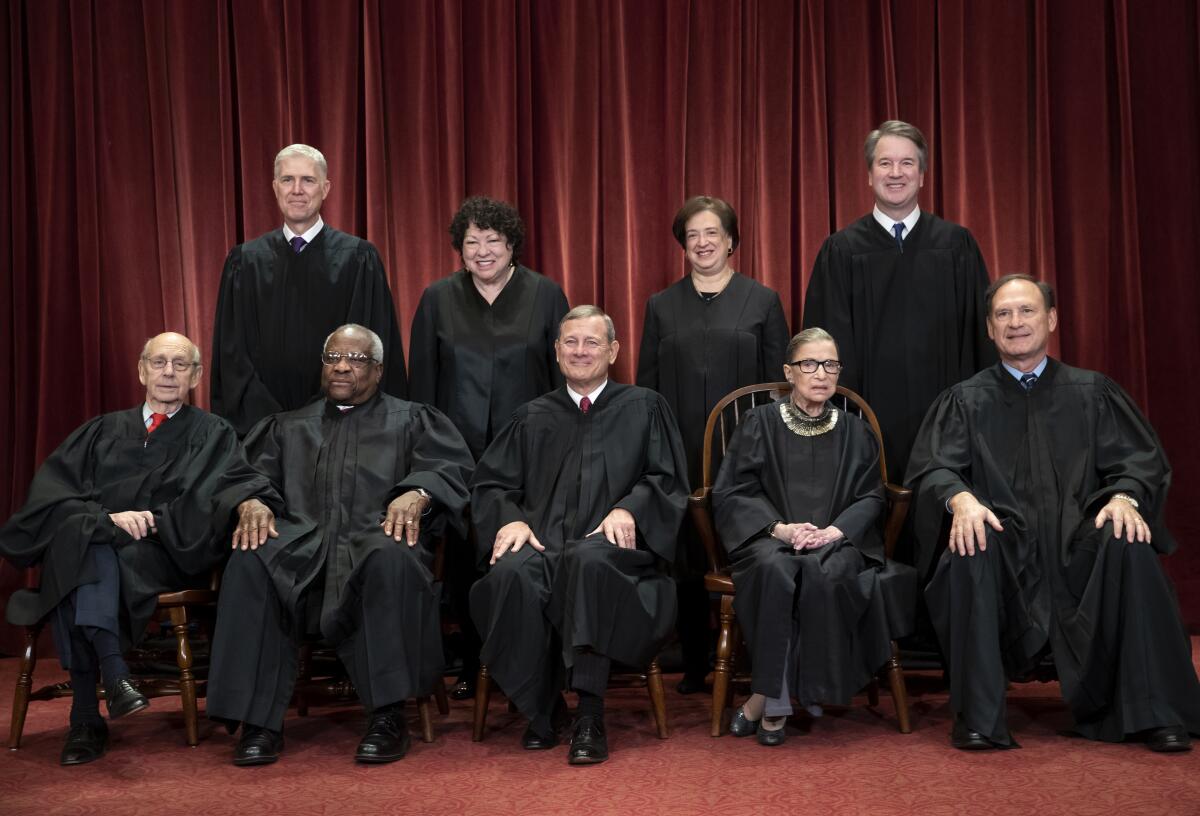
- Share via
The notion that Democrats should dramatically remake the Supreme Court the moment they control the White House and both chambers of Congress has been simmering in the party’s progressive wing for a couple of years.
The death of Ruth Bader Ginsburg has placed it on the front burner, where it belongs.
In its most common form, the remaking would take the form of expanding the court from its current nine members to at least 13. That’s the version Erwin Chemerinsky, the dean of UC Berkeley’s law school, advocated in a Sept. 18 column in The Times.
The American people should have a voice in the selection of their next Supreme Court Justice. Therefore, this vacancy should not be filled until we have a new president.
— Senate Majority Leader Mitch McConnell, R-Ky., in 2016
Chemerinsky raised the idea in the context of what might be an unseemly rush by the White House and Senate Republicans to nominate and confirm a conservative justice to replace Ginsburg prior to the November election.
“One way for Democrats to make clear they will not tolerate Republicans trying to fill this seat in advance of the election,” Chemerinsky wrote, “would be for them to pledge that, if they take the White House and Senate in November, they will increase the size of the Supreme Court to 13 justices.”
The stakes could not be higher today.
With the Supreme Court firmly in the hands of conservatives, constitutional scholar Garrett Epps wrote in the Atlantic in 2018, “The Court’s progress on LGBT rights will almost certainly come to an end; its faint interest in protecting the political process from political gerrymandering will also disappear.”
The 1973 abortion rights decision Roe vs. Wade and its 1992 successor, Casey vs. Planned Parenthood Assn. of Southern Pennsylvania, hang in the balance, as does the Affordable Care Act.
With the prospect looming of a Supreme Court dominated by Trump-appointed right-wing judges into the foreseeable future, an idea for a possible counterstroke has begun percolating among progressive political analysts and legal theorists: Expand the court from the current nine justices to provide for a more balanced, if not distinctly liberal, bench.
The ACA is in grave danger thanks to a Texas-led lawsuit aiming to declare the law unconstitutional. The lawsuit is scheduled to be heard by the court in mid-November.
That’s after the election, but at a time when the court will either be split 4-4 or under the thumb of three Trump-appointed justices. If the former, than a lower-court ruling striking the law will stand, disastrously.
Chemerinsky, like many other progressive legal scholars, has been a long-term advocate of the expansion. “It is the only way to keep there from being a very conservative court for the next 10-20 years,” he told me in June 2018, the last time I wrote about the idea.
At the time, Justice Anthony Kennedy, who was considered a swing justice based on his history of lining up sometimes with conservatives and sometimes with liberals, had just announced his retirement. President Trump ultimately replaced Kennedy with Brett Kavanaugh, who has been a reliable conservative vote. The prospect of a further veer right was manifest.
As I observed then, the court’s liberal wing included two justices in the twilight of their years — Ginsburg was then 85 and Stephen Breyer, 79. By contrast, the conservative bloc then comprised relative spring chickens. None was older than 70 (Clarence Thomas), two in their 60s, and one (Neil Gorsuch) only 50. Kavanaugh is 55.
The authority of Congress to establish the size of the Supreme Court isn’t in doubt. The Constitution mandates only that there be a chief justice but implicitly, via Article III, leaves the size of the bench to that branch.
Acts of Congress variously set the size of the court at six members from 1789 to 1807, seven until 1837, nine from then to 1863, 10 from 1863 to 1866, and seven from then until the current strength was enacted into law in 1869.
Trump is determined to overthrow the Affordable Care Act, a move that would rip health coverage from some 23 million Americans during a pandemic.
Expanding the court to 13 justices or even more wouldn’t guarantee a liberal bench in perpetuity, of course. But it might prevent any single president from drastically remaking the court, because it would take more appointments to make a difference.
Most presidents have had scant opportunity to fashion a court to their preference: 24 of the 45 have appointed two justices or fewer.
The idea of expanding the court anew rests on two legislative markers. One is Franklin Roosevelt’s 1937 court-packing scheme, which was a notable flop. More on that in a moment. The other is Mitch McConnell’s court-packing scheme of 2016, which was successful.
Indeed, the refusal of Senate Majority Leader McConnell (R-Ky.) to even hold Senate hearings on Barack Obama’s nomination of Merrick Garland to the court in 2016, following the death of the conservative Antonin Scalia, is occasioning an outburst of hypocrisy and dishonesty among Senate Republicans today.
It will be remembered that McConnell based his refusal to consider Garland on the ginned-up principle that, with a presidential election just nine months away, “the American people should have a voice in the selection of their next Supreme Court Justice. Therefore, this vacancy should not be filled until we have a new president.”
McConnell thereby banked the nomination against a possible Republican victory that November, effectively packing the court with a conservative majority.
FDR’s New Deal aimed not to stimulate the economy, but protect families from hardship.
Any people who thought that McConnell would apply his principle consistently to a vacancy opening just six weeks before an election don’t know their Mitch. He already is claiming that the principle applied only when the White House and Senate were held by opposing parties, as was the case then, not by the same party, as is the case now.
Such ex post facto reasoning is also on display from Sen. Lindsey Graham (R-S.C.), who couldn’t have been more clear in 2016 when he said, “I want you to use my words against me. If there’s a Republican president in 2016 and a vacancy occurs in the last year of the first term, you can say Lindsey Graham said let’s let the next president, whoever it might be, make that nomination.”
Graham is now chair of the Senate Judiciary Committee, which will oversee a Supreme Court nomination. His walkback is even more dishonest than McConnell’s: He’s arguing that, among other things, Democrats and “the liberal media conspired to destroy the life of Brett Kavanaugh and hold that Supreme Court seat open.”
That brings us to FDR’s scheme. Roosevelt was acting in accordance with what he perceived to be popular discontent with the court following a string of rulings, guided by a strong conservative bloc, overturning New Deal initiatives. This discontent increased in the wake of a 1936 ruling known as Tipaldo, after its contemptible protagonist, a slave-driving New York factory owner.
The ruling, which overturned a New York law setting a minimum wage for women on grounds of the supposed constitutional sanctity of the contract between employers and their employees, even united two old adversaries.
They were Herbert Hoover, who proposed a constitutional amendment to overturn it, and Harold Ickes, a liberal Republican who was FDR’s Interior secretary and who castigated the court for upholding “the sacred right ... of an immature child or a helpless woman to drive a bargain with a great corporation.” Ickes added, “If this decision does not outrage the moral sense of the country, then nothing will.”
Henry A. Wallace, FDR’s vice president, foresaw the fascism of Trump.
Yet in this case FDR uncharacteristically misread his public. He was faulted for rolling out the plan as a surprise, and without consultation with congressional allies.
Moreover, his scheme was elaborate to a fault: Its mechanism was to add a new justice whenever an existing justice reached the age of 70, up to a maximum of 15. This was seen as a personal affront to the six justices who already had reached that age, including Louis Brandeis, a leading liberal, and Chief Justice Charles Evans Hughes.
Under Hughes’ leadership — and possibly his concern that FDR would make good on his threat to remake the court — the justices already had begun to move away from their opposition to the New Deal and worker rights.
In the spring of 1937, the court upheld a Washington state minimum wage law, collective bargaining rights under the National Labor Relations Act, and Social Security. (The vote change on minimum wage by Justice Owen Roberts, who upheld the Washington law but had earlier voted against the New York statute, was dubbed “the switch in time that saved nine.”) Roosevelt ultimately withdrew the court-packing scheme.
The Supreme Court today is already as out-of-step with popular politics as its 1930s predecessor. Most Americans favor abortion rights, the Affordable Care Act and protections for LGBTQ people from discrimination. Official attacks on voting rights, especially those of Black and other minority voters, have proliferated since 2013, when this Supreme Court tossed out key provisions of the Voting Rights Act of 1965.
The Supreme Court’s rightward lurch, which would only become more dramatic and more lasting with a premature filling of Ginsburg’s seat, threatens the court’s credibility and, much more serious, democracy itself. There may be only one way to save both.
More to Read
Inside the business of entertainment
The Wide Shot brings you news, analysis and insights on everything from streaming wars to production — and what it all means for the future.
You may occasionally receive promotional content from the Los Angeles Times.

